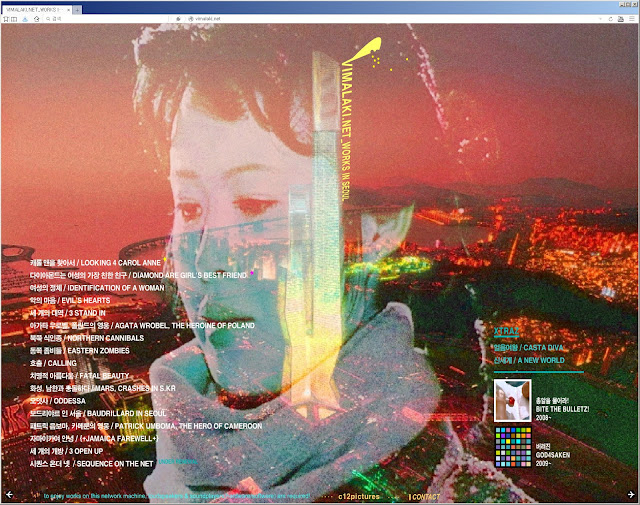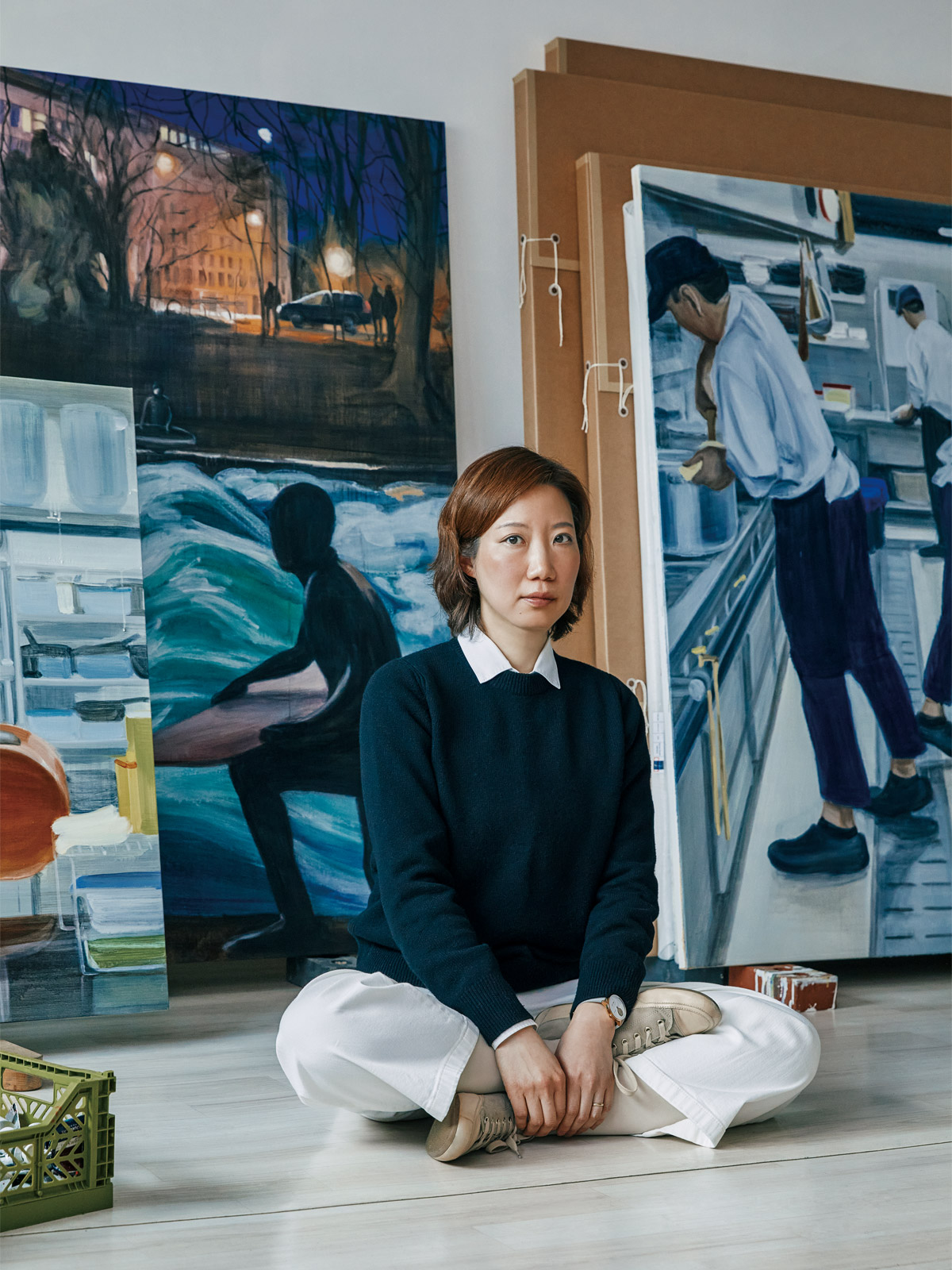Pioneering Korean web art artist, Rho Jae Oon (b. 1971) reflects on the conditions of image production and reception shaped by changes in the digital media environment, where films are replicated and distributed at high speeds through the internet. He has established his own website, where he collects and re-edits various images circulating online, uploading his creations as a form of "web-movie."

Rho Jae Oon, vimalaki.net, 2001- ©C12 Pictures
In 1998, Rho launched a website where he could upload collected data, share it with a wide, anonymous audience, and exchange ideas. Building on this, he created the website ‘vimalaki.net’ in 2000 as a “web-theater.” The artist gathered scenes from movies, documentary images, and other visuals circulating on the internet, reassembling and uploading them to vimalaki.net.
 Rho Jae Oon, Sequence
on the net, 2000 ©C12 Pictures
Rho Jae Oon, Sequence
on the net, 2000 ©C12 PicturesThe
website featured works such as Sequence on the net, which
revealed two sequences through hyperlinks; A New World,
composed solely of film openings and credits; and Fatal
Beauty, a close-up of North Korean female cheerleaders depicted in
media.
Rho Jae
Oon not only produced these films but also established a one-person system to
manage the distribution and operation of the web-theater ‘vimalaki.net.’ His
work closely resonates with the perceptual structures of the digital age, where
modern individuals encounter and interpret the world through intangible data.

Rho Jae Oon, God For Saken, 2009 ©MMCA
The
films featured on Rho’s website do not follow the traditional format or
distribution methods of cinema. Unlike the conventional viewing model—requiring
audiences to attend screenings at a specific time in a theater setting—his web
movies, similar to today’s experience of OTT services via smartphones, are
accessible within a single platform, where viewers can click and watch any film
without spatial or temporal constraints.
Additionally,
his films are composed as montages of discontinuous images from various
sources, defying the linear, time-bound narrative structure of conventional
cinema.
For
instance, God For Sake (2009), a web-based film presented on
vimalaki.net, consists of 14 re-edited video segments taken from classic noir
films. Viewers initially encounter a screen with a grid of brightly colored
rectangular shapes; clicking on any shape activates its corresponding video.
Each segment portrays psychological landscapes filled with anxiety,
fragmentation, anger, fantasy, dreams, and fear, offering a rich depiction of
human emotional states.
 Rho Jae Oon, 3
Open Up, 2001 ©MMCA
Rho Jae Oon, 3
Open Up, 2001 ©MMCAThrough this approach, the artist explores
the cinematic potential of the web and the impact of digital environments on
our senses and perception, while simultaneously rethinking concrete issues in
reality through these media. For example, 3 Open Up (2001)
is a work created on the web that reflects on vision and perception after the
artist’s visit to the DMZ. The project comprises three episodes.
The first video overlays a satellite image
resembling a nuclear plant found online with news footage of South Korean
President Kim Dae-jung’s 2000 visit to North Korea. The second video focuses on
an accidental wildfire within the DMZ, while the third combines visuals of an
advanced American AWACS surveillance plane, based in Japan, conducting
operations against a blue sky, overlaid with an anchor’s voice.

Rho Jae Oon, Bite The Bullet!, 2008 ©C12 Pictures
Further expanding his practice, Rho Jae Oon presented Bite The Bullet! (2008), a "web-publishing" project structured in the form of book chapters. This work, composed of multiple chapters of image, text, and sound montages, resembles a book in format while intricately deconstructing and transforming the audiovisual elements of cinematic images. Through this process, he creates perceptual gaps, inviting viewers to experience the images in fragmented, multifaceted ways.

Rho Jae Oon, S.Kr is Super Interface, 2001-2004 ©C12 Pictures
In Rho’s 2004 solo exhibition “Skins of
S_Kr,” held at Insa Art Space, his online-based works expanded into an offline
setting. The exhibition took place in the physical gallery space and
simultaneously online (www.time-image.co.kr).
Rho explained that the exhibition was
created using ubiquitous data flowing over the surface of South Korea. He
edited images sourced from the internet through a digital processing method he
devised called "universal display images," then printed and installed
these in the gallery.
“Universal display images” refer to images
that can be variably displayed offline without constraints on format, material,
or size. These printed works evoke various art forms, while also distinguishing
themselves from traditional media formats, allowing viewers to imagine diverse
narratives.
 Rho Jae Oon, Jataka
Mirrors (Mirrors of Previous Birth), 2011, Installation view of “Mulian
Mulian” (Atelier Hermès, 2011) ©C12 Pictures
Rho Jae Oon, Jataka
Mirrors (Mirrors of Previous Birth), 2011, Installation view of “Mulian
Mulian” (Atelier Hermès, 2011) ©C12 PicturesIn this way, Rho transforms the offline exhibition space into an interface that reconstructs real-world issues through flexible, fragmented images. In his 2011 solo exhibition “Mulian Mulian” at Atelier Hermès, he connected the story of Mulian, the protagonist of the Buddhist scripture The Sutra of Mulian, to contemporary society, presenting it through various interfaces.

Installation view of “Mulian Mulian” (Atelier Hermès, 2011) ©C12 Pictures
The
Sutra of Mulian presents a universal archetype of
"salvation," depicting the story of Mulian, one of Buddha's ten great
disciples, who saves his mother from hell after her death. The artist connected
Mulian's story with his reflections on poverty, disease, and concepts of hell
prevalent in today's world, presenting them through artistic experimentation.
In this exhibition, he set the gallery space itself as a kind of
"hell."
Here,
hell is redefined as an interface that reflects the modern reality dominated
not by traditional imagery but by film, CG, the internet, and augmented
reality. The exhibition includes material works, such as the printing work from
re-edited film stills and installations, which collectively serve as an
interface, linking the elements together and filtering reality.
 Rho Jae Oon, Universal
Cinema 2019, 2019, Installation view of “Media Punk: Belief, Hope,
Love” (ARKO Art Center, 2019) ©ARKO Art Center
Rho Jae Oon, Universal
Cinema 2019, 2019, Installation view of “Media Punk: Belief, Hope,
Love” (ARKO Art Center, 2019) ©ARKO Art CenterIn the 2019 exhibition “Media Punk: Belief,
Hope, Love” at ARKO Art Center, Rho presented an installation as an interface titled
Universal Cinema 2019, where video, objects, and images
originating from a wide media environment are interconnected and compatible
within the exhibition space, transcending their original contexts.
This work invites viewers to
experience images that change according to their movement through the space,
incorporating the act of photographing the landscape with their mobile phones
or sharing it on personal platforms. Universal Cinema 2019
can be described as a form of augmented reality space and a moving theater that
realizes and observes contemporary modes of image use and consumption.

Rho Jae Oon, Universal Cinema, 2017 ©C12 Pictures
In this way, Rho Jae Oon has showcased web art as "film" and installation works as "interfaces," reflecting on how various visual information in today’s media environment influences our perceptual systems. By linking these works to concrete issues in reality, he disrupts traditional ways of perceiving visual information, enabling a new sensory engagement with reality and the imagination of the future.
"Homo Cinematicus,’ we often say that humans
are cinematic beings. Just like the films we watch in theaters, we think of
movies as a 'reflection of reality.'
However, the film originally possessed richer
possibilities and potential but has solidified into the forms we see today.
Don't you think we need a new transition to realize that there are other
aspects? It’s about exploring those possibilities.”

노재운 작가 ©NEMAF
Rho Jae Oon graduated from Hongik
University’s Paintings Department in 1997. He began his solo exhibitions with “Skins
of S_Kr” at Insa Art Space in 2004, followed by “Black Gold in Switzerland”
(Art Space Pool, 2006), “Mulian Mulian” (Atelier Hermès, 2011), and “Cosmic Joke” (Art Space Pool, 2018).
He has also participated in numerous group exhibitions,
including the Gwangju Biennale (2006), “Museum as HUB” (New Museum, New York,
2008), the 10th Hermès
Foundation Art Award Finalists Exhibition (Atelier Hermès, 2009), “Space Study” (PLATEAU, Samsung Museum of
Art, 2011), Busan Biennale (2012), “No Comment” (Seoul National University
Museum of Art, 2013), Media_City Seoul (2014), and “WEB-RETRO” (Buk-Seoul
Museum of Art, 2019).
Currently, he serves as the director of C12
Pictures, where he plans, produces, exhibits, screens, and distributes his
works.
References
- C12 픽처스 (C12 Pictures)
- 플랫폼엘, 카운터타임 (Platform-L, COUNTERTIME)
- 국립현대미술관, 노재운 | 버려진 | 2009 (National Museum of Modern and Contemporary Art Korea (MMCA), Rho Jae Oon | God For Saken | 2009)
- 국립현대미술관, 노재운 | 3개의 개방 | 2001 (National Museum of Modern and Contemporary Art Korea (MMCA), Rho Jae Oon | 3 Open Up | 2001)
- 류병학, 웹 영화감독 노재운, 2011
- 서울시립미술관(Seoul Museum of Art), WEB-RETRO
- 아뜰리에 에르메스, 목련아 목련아 (Atelier Hermès, Mulian Mulian)
- 아르코미술관, 미디어펑크: 믿음, 소망, 사랑 (ARKO Art Center, Media Punk: Belief, Hope, Love)



















